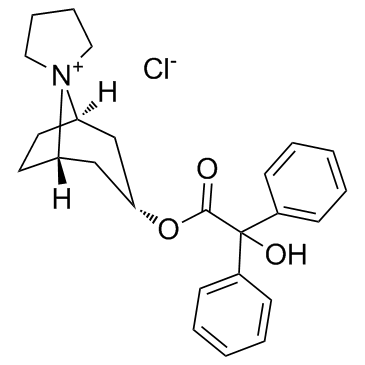Trospium Chloride

Trospium Chloride structure
|
Common Name | Trospium Chloride | ||
|---|---|---|---|---|
| CAS Number | 10405-02-4 | Molecular Weight | 392.510 | |
| Density | N/A | Boiling Point | N/A | |
| Molecular Formula | C25H30ClNO3 | Melting Point | 266-268ºC | |
| MSDS | N/A | Flash Point | N/A | |
| Symbol |

GHS07 |
Signal Word | Warning | |
|
New strategies for medical management of overactive bladder in children.
Curr. Opin. Urol. 20(4) , 313-7, (2010) The medical treatment of children with non-neurogenic overactive bladder syndrome (OAB) is still limited to a small number of drugs approved for use in childhood according to the national regulations of each country.Over the last few years, there were several... |
|
|
What is the success of drug treatment in urge urinary incontinence? What should be measured?
Arch. Gynecol. Obstet. 287(3) , 511-8, (2013) The aim of this study is to evaluate the efficacy and the tolerability of three classic antimuscarinic drugs used in the treatment of over active bladder syndrome using clinical data and quality of life tests, and to evaluate the parameters affecting the succ... |
|
|
Benefits and harms of pharmacologic treatment for urinary incontinence in women: a systematic review.
Ann. Intern. Med. 156(12) , 861-74, W301-10, (2012) Urinary incontinence (UI) in women adversely affects quality of life.To conduct a systematic literature review of drugs for urgency UI in women.MEDLINE, the Cochrane Central Register of Controlled Trials, SCIRUS, and Google Scholar were searched for articles ... |
|
|
Mechanistic investigation of food effect on disintegration and dissolution of BCS class III compound solid formulations: the importance of viscosity.
Biopharm. Drug Dispos. 33(7) , 403-16, (2012) A negative food effect, i.e. a decrease in bioavailability upon the co-administration of compounds together with food, has been attributed particularly with high solubility/low permeability compounds (BCS class III). Different mechanisms have been proposed in... |
|
|
Trospium chloride--an effective drug in the treatment of overactive bladder and detrusor hyperreflexia.
World J. Urol. 19(5) , 336-43, (2001) Trospium chloride (TCL), a quaternary ammonium derivative of nortropanol, has been evaluated in a number of clinical and pharmacological studies. Selected pharmacological and clinical pharmacokinetic data are discussed as providing a basis for a better interp... |
|
|
Mechanistic basis for unexpected bioavailability enhancement of polyelectrolyte complexes incorporating BCS class III drugs and carrageenans.
Eur. J. Pharm. Biopharm. 85(1) , 26-33, (2013) The objective of this study was to investigate the potential of λ-carrageenan to work as an absorption modifying excipient in combination with formulations of BCS class 3 substances. Trospium chloride was used as a model BCS class 3 substance. Polyelectrolyte... |
|
|
Trospium chloride for the treatment of overactive bladder with urge incontinence.
Clin. Ther. 27(5) , 511-30, (2005) Urinary incontinence is caused by an overactive bladder, leading to symptoms of urgency, frequency, and incontinence. Urge incontinence occurs predominantly in women as they age.This article reviews the current primary literature concerning the efficacy and t... |
|
|
Brain penetration of the OAB drug trospium chloride is not increased in aged mice.
World J. Urol. 31(1) , 219-24, (2013) To analyse whether the permeability of the blood-brain barrier to the antimuscarinic drug trospium chloride is altered with ageing. This is a relevant question for elderly patients with overactive bladder syndrome who are treated with trospium chloride as the... |
|
|
Trospium chloride: an anticholinergic quaternary ammonium compound for the treatment of overactive bladder.
Expert Opin. Pharmacother. 6(8) , 1409-20, (2005) The International Continence Society has defined overactive bladder (OAB) as urinary urgency, with or without urge urinary incontinence, usually with urinary frequency and nocturia. Approximately 17% of men and women in the US report OAB symptoms, which can a... |
|
|
Once-daily trospium chloride 60 mg extended-release provides effective, long-term relief of overactive bladder syndrome symptoms.
Neurourol. Urodyn. 30(7) , 1214-9, (2011) Once-daily extended-release (XR) trospium chloride has been evaluated for the treatment of overactive bladder syndrome (OAB) in two 12-week randomized, double-blind, placebo-controlled studies. This pooled analysis of the 9-month open-label extensions to thes... |